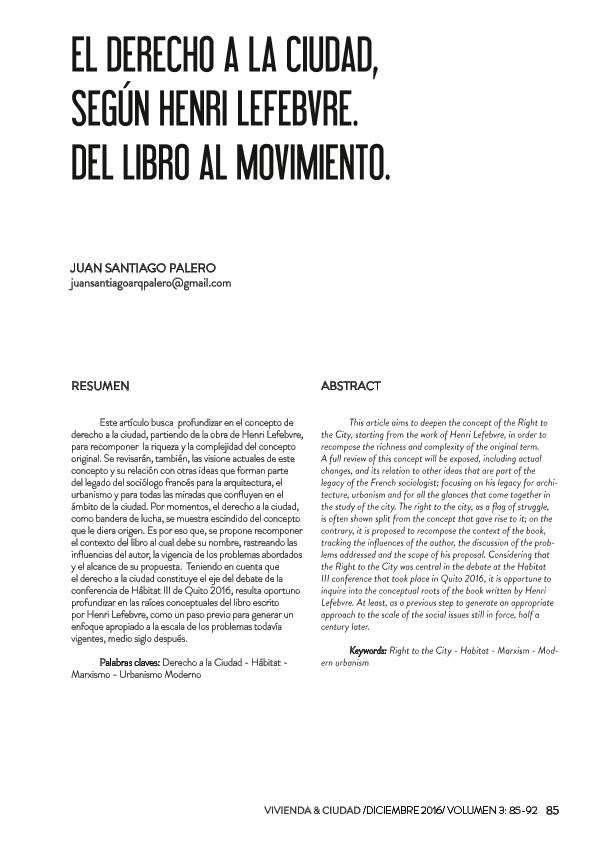Mostrar el registro sencillo del ítem
dc.contributor.author
Palero, Juan Santiago

dc.date.available
2022-12-02T13:01:47Z
dc.date.issued
2016-12
dc.identifier.citation
Palero, Juan Santiago; El derecho a la ciudad, según Henri Lefebvre: del libro al movimiento; Universidad Nacional de Córdoba. Facultad de Arquitectura, Urbanismo y Diseño. Instituto de Investigación de Vivienda y Hábitat; Vivienda & Ciudad; 3; 12-2016; 85-92
dc.identifier.uri
http://hdl.handle.net/11336/179966
dc.description.abstract
Este artículo busca profundizar en el concepto de derecho a la ciudad, partiendo de la obra de Henri Lefebvre, para recomponer la riqueza y la complejidad del concepto original. Se revisarán, también, las visione actuales de este concepto y su relación con otras ideas que forman parte del legado del sociólogo francés para la arquitectura, el urbanismo y para todas las miradas que confluyen en el ámbito de la ciudad. Por momentos, el derecho a la ciudad, como bandera de lucha, se muestra escindido del concepto que le diera origen. Es por eso que, se propone recomponer el contexto del libro al cual debe su nombre, rastreando las influencias del autor, la vigencia de los problemas abordados y el alcance de su propuesta. Teniendo en cuenta que el derecho a la ciudad constituye el eje del debate de la conferencia de Hábitat III de Quito 2016, resulta oportuno profundizar en las raíces conceptuales del libro escrito por Henri Lefebvre, como un paso previo para generar un enfoque apropiado a la escala de los problemas todavía vigentes, medio siglo después.
dc.description.abstract
This article aims to deepen the concept of the Right to the City, starting from the work of Henri Lefebvre, in order to recompose the richness and complexity of the original term. A full review of this concept will be exposed, including actual changes, and its relation to other ideas that are part of the legacy of the French sociologist; focusing on his legacy for architecture, urbanism and for all the glances that come together in the study of the city. The right to the city, as a flag of struggle, is often shown split from the concept that gave rise to it; on the contrary, it is proposed to recompose the context of the book, tracking the influences of the author, the discussion of the problems addressed and the scope of his proposal. Considering that the Right to the City was central in the debate at the Habitat III conference that took place in Quito 2016, it is opportune to inquire into the conceptual roots of the book written by Henri Lefebvre. At least, as a previous step to generate an appropriate approach to the scale of the social issues still in force, half a century later.
dc.format
application/pdf
dc.language.iso
spa
dc.publisher
Universidad Nacional de Córdoba. Facultad de Arquitectura, Urbanismo y Diseño. Instituto de Investigación de Vivienda y Hábitat
dc.rights
info:eu-repo/semantics/openAccess
dc.rights.uri
https://creativecommons.org/licenses/by-sa/2.5/ar/
dc.subject
HENRI LEFEBVRE
dc.subject
DERECHO A LA CIUDAD
dc.subject
URBANISMO
dc.subject
MOVIMIENTOS SOCIALES
dc.subject.classification
Estudios Urbanos

dc.subject.classification
Geografía Económica y Social

dc.subject.classification
CIENCIAS SOCIALES

dc.title
El derecho a la ciudad, según Henri Lefebvre: del libro al movimiento
dc.type
info:eu-repo/semantics/article
dc.type
info:ar-repo/semantics/artículo
dc.type
info:eu-repo/semantics/publishedVersion
dc.date.updated
2022-12-01T14:22:31Z
dc.identifier.eissn
2422-670X
dc.journal.number
3
dc.journal.pagination
85-92
dc.journal.pais
Argentina

dc.journal.ciudad
Córdoba
dc.description.fil
Fil: Palero, Juan Santiago. Consejo Nacional de Investigaciones Científicas y Técnicas. Centro Científico Tecnológico Conicet - Córdoba; Argentina. Universidad Nacional de Córdoba. Facultad de Arquitectura, Urbanismo y Diseño. Instituto de Investigación de la Vivienda; Argentina
dc.journal.title
Vivienda & Ciudad
dc.relation.alternativeid
info:eu-repo/semantics/altIdentifier/url/https://revistas.unc.edu.ar/index.php/ReViyCi/article/view/16283
Archivos asociados
